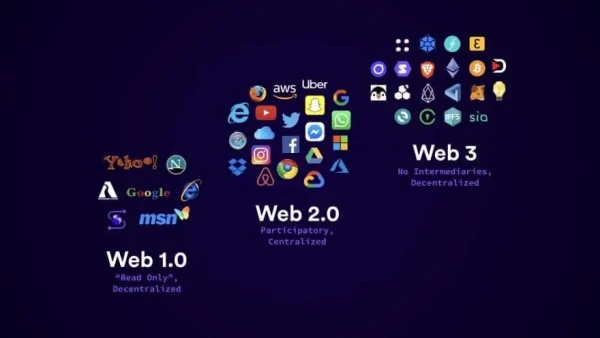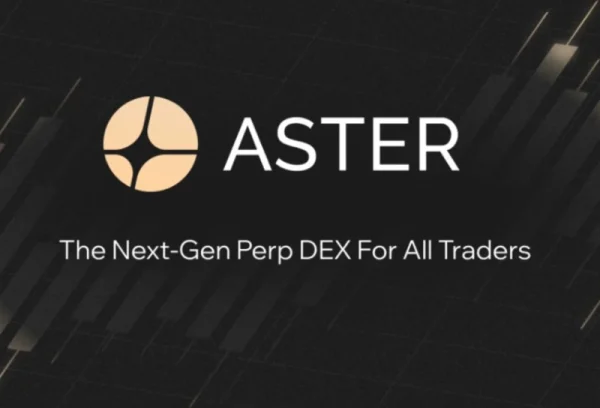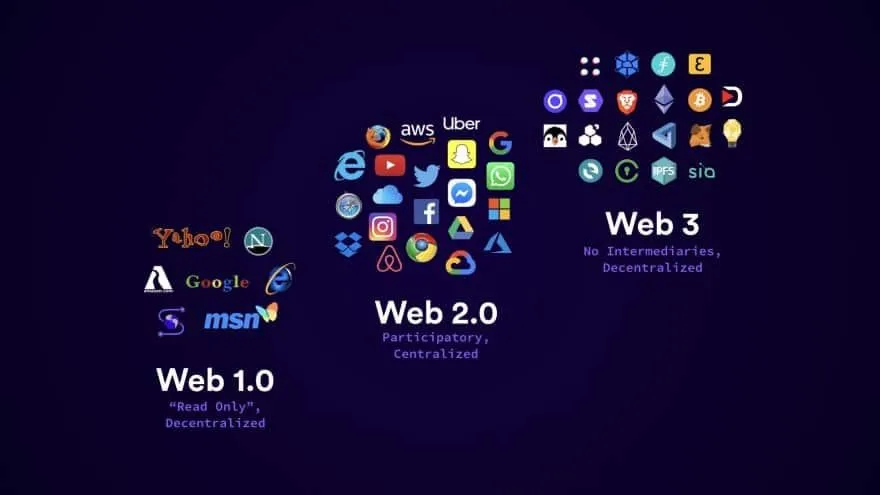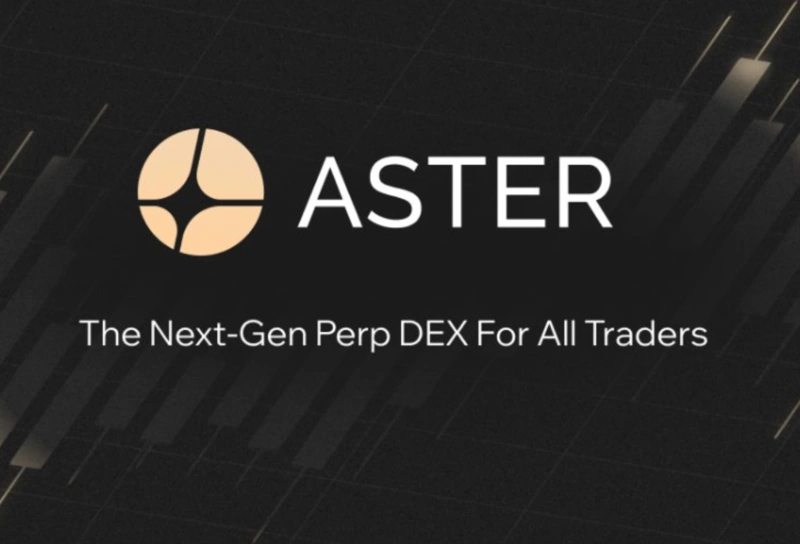Differences Between DeFi and Web3
There are some differences between DeFi and Web3 as they focus on different aspects. DeFi is all about financial activities, and Web3 is about building a more user-controlled internet.
This article highlights the characteristics of Web3 and DeFi, and their unique roles.
Table of content
The Main Differences Between DeFi and Web3
Here's a comparison of DeFi and Web3 characteristics:
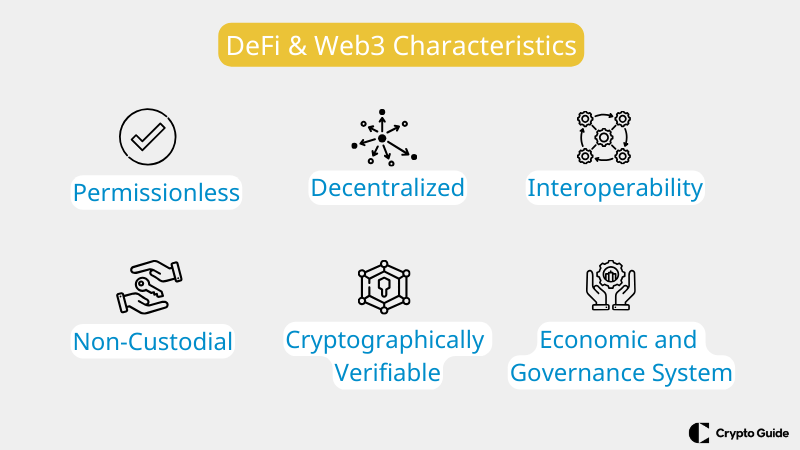
Permissionless
DeFi
In DeFi, anyone can join in financial activities without central approval. You can use DeFi platforms like lending or exchange without permission or ID checks.
Web3
In Web3, permissionless means anyone can use DApps freely. You're free to interact with services and protocols online without approval.
Decentralized
DeFi
Control and decision-making are spread out across many nodes instead of one central authority. DeFi platforms work on blockchains, where transactions are checked by lots of people. It makes things transparent and resistant to censorship.
Web3
Decentralization is key in Web3, where data and services are spread out across lots of nodes, not controlled by one group. This setup makes things more secure, tough, and private for users by reducing reliance on central intermediaries.
Interoperability
DeFi
Different finance platforms can work together smoothly, sharing value. This lets developers mix and match DeFi pieces to make new financial stuff.
Web3
Interoperability in Web3 is about different blockchain networks and apps talking to each other easily. It lets assets and data move around different platforms.
Non-Custodial
DeFi
Non-custodial means users keep control and ownership of their assets when using DeFi platforms. They hold onto their private keys and assets, removing the need to trust centralized middlemen with their funds.
Web3
Non-custodial services in Web3 mean users have complete control over their data and online identities. They own their personal info and can choose to share it with apps without giving up control to big platforms.
Cryptographically Verifiable
DeFi
They are cryptographically verifiable, so anyone on the blockchain can check that they're legit. Cryptographic signatures ensure transactions are secure and transparent.
Web3
Cryptographically verifiable data on the decentralized web ensures info is genuine. Techniques like digital signatures let users confirm data and transactions without authorities.
Economic and Governance System
DeFi
DeFi platforms often use token-based systems for both economics and governance. Users with tokens can join in decision-making and governance by holding and staking tokens. Token holders may get voting rights to suggest and decide on changes or upgrades.
Web3
Web3 projects also use token-based systems to encourage involvement and align incentives. These systems let stakeholders control the development of decentralized apps and protocols.
What Is DeFi and How Does It Work?
DeFi uses smart contracts to move money without banks. These contracts are written in code and can do things by themselves. This could change how we use money every day.
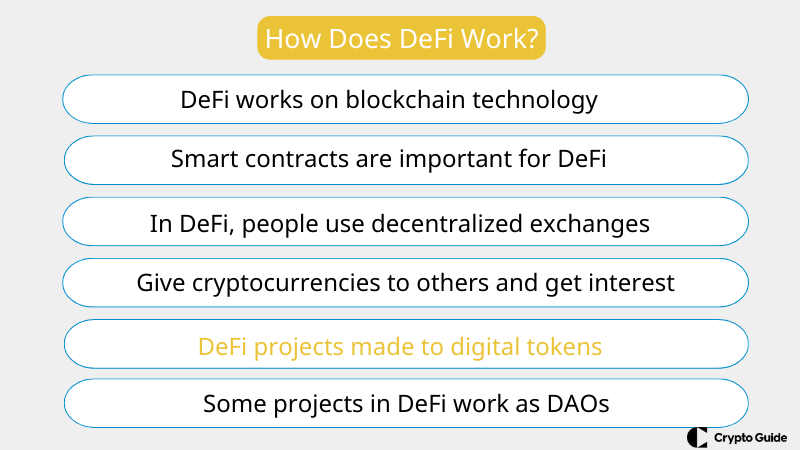
Here's how DeFi works:
Blockchain Record-Keeping for DeFi
DeFi works on blockchain technology. Ethereum is often used here because it has smart contract capabilities. The blockchains offer a safe and clear record-keeping method for transactions.
Smart Contracts, the Foundation of DeFi
Smart contracts are like automatic agreements in computer code. They are important for DeFi. These contracts do things by themselves when certain rules are met. In DeFi, they help with money tasks. This includes lending money, borrowing, and trading.
Decentralized Exchanges (DEXs) in DeFi
In DeFi, people use decentralized exchanges rather than centralized ones. This happens because they do not want to lose anonymity or go through KYC process. DEXs let people make trades of their cryptocurrency directly between themselves.
Lending and Borrowing in DeFi
Lending and borrowing in DeFi means people can give their cryptocurrencies to others for some time and get interest. Also, they can take loans by giving something valuable as security. You can use Bitcoin can as collateral to take out a stablecoin loan.
Tokenization in DeFi
Tokenization in DeFi projects means taking assets from the real world and making them into digital tokens on the blockchain.
Decentralized Autonomous Organizations (DAOs) in DeFi
In DeFi, some initiatives are structured as DAOs. They allow token owners to govern by casting votes, reflecting the core concepts of how DAOs operate in the decentralized finance.
Impact of DeFi on the Financial Industry
DeFi is changing the financial industry by making it easier for everyone to use financial services.
Challenges and Growth of DeFi
It is important to know that DeFi is at the beginning phase and has issues like safety measures and following government rules.
What Is Web3 and How Does It Work?
Web3 is the name for the next phase of the internet. It focuses on using decentralized systems. These systems put privacy and ownership of data in the hands of users.
Unlike the current internet, Web3 doesn't rely on big companies' servers. It uses networks and blockchain technology to give control to individual people.
Here's how Web3 works:
Decentralized Storage and Control
Web3 works on a system that is not centralized, using blockchain often. It doesn't depend on just one place for data; instead, the information is in many nodes in the network. That helps against control from others and reduces risk if one part fails.
Blockchain as Foundation of Web3
Blockchain technology is the base that supports applications on Web3. It offers a safe and clear record-keeping system for all transactions and data storage. Every block within the blockchain holds a special hash that comes from the one before it, making a chain of blocks that cannot be changed.
Smart Contracts, the Self-executing Agreements
Smart contracts run themselves because the agreement's details are coded directly. They make transactions possible when certain agreed-upon conditions happen.
Smart Contracts in DeFi
Smart contracts form a part of Web3 applications, especially decentralized finance, known as DeFi.
Decentralized Applications (DApps)
Web3 allows the creation and use of DApps, which function on blockchain systems. DApps work of any authority. They depend on smart contracts to manage how users interact with each other.
Various Forms of Web3 DApps
Web3 DApps come in various forms. It can be exchanges that operate without central control (known as DEXs). It can also be social networks where decentralization is key.
User Empowerment and Data Ownership
In Web3, people have more power over their own information and online identity. They do not give their data to central services but use private keys to communicate with decentralized applications. It lets users own their data and decide who gets to see it.
Blockchain Systems
Web3 lets blockchain systems and protocols work together so money and data can move around. This helps people be more creative and work together better online.
Fairness and Inclusivity
Web3 is all about making the internet more fair, clear, and focused on the people using it. It uses blockchain and the idea that no person or group should control everything. So everyone can have a say, and new things can happen. It's like creating a digital world where everyone can join in and do their thing.
Is DeFi a Part of Web3?
Yes, DeFi is part of Web3. Web3 is the new version of the Internet that focuses on spreading control. DeFi is about decentralized applications, and it uses blockchain technology as its foundation.
Web3 is all about using new technology to make financial services better. DeFi is a big part of this. It lets people borrow and lend money, trade things of value, and get insurance, all without using traditional banks.
In short, DeFi is a new way to manage your money using the internet. It's all about making financial services open to everyone without needing banks or other middlemen.
DeFi projects work on open blockchain networks, such as Ethereum. Smart contracts help manage transactions automatically and keep the rules in place. It lets users use financial services immediately without middlemen like banks or brokers.
So, DeFi is an important part of the Web3. It changes financial services so they are easier for everyone to use, work better, and include more people.
What is The Future of DeFi and Web3?
The future of DeFi and Web3 can change how we use finance and the internet. Here are some important trends experts see:
Increased Integration
DeFi apps will blend more with Web3 tech, making it easier for users. Picture managing your investments from your Web3 browser.
More Security
Expect better security in DeFi to tackle the hacking issues seen in its early days.
Cross-Platform Functionality
The platforms can work better together, letting users move assets.
Mainstream
As DeFi and Web3 improve, more people, including traditional financial firms, can use them.
While DeFi and Web3 are new, they face challenges like regulations and scalability. Yet, the potential benefits are huge, and innovation is happening fast.
DeFi vs. Web3 Summarized
There are some differences between DeFi and Web3. DeFi changes finance by removing the middlemen and using blockchain technology. It offers decentralized services like lending and trading.
Web3 decentralizes the internet. Utilizing blockchain to improve security and user freedom gives users more control over their online activities.
FAQ About DeFi and Web3
What's the difference between Web3 and DeFi?
Web3 is a broader vision of decentralized internet and DeFi is decentralized financial system.
Is Web3 part of DeFi?
Web3 is the foundation upon which DeFi is built.
Is Web3 decentralized?
Yes, Web3 is inherently decentralized.
What are the important benefits of DeFi?
DeFi offers transparency, permissionless access, and potentially more efficient financial services.
What is the biggest challenge about DeFi?
Scalability remains the biggest challenge for DeFi.

